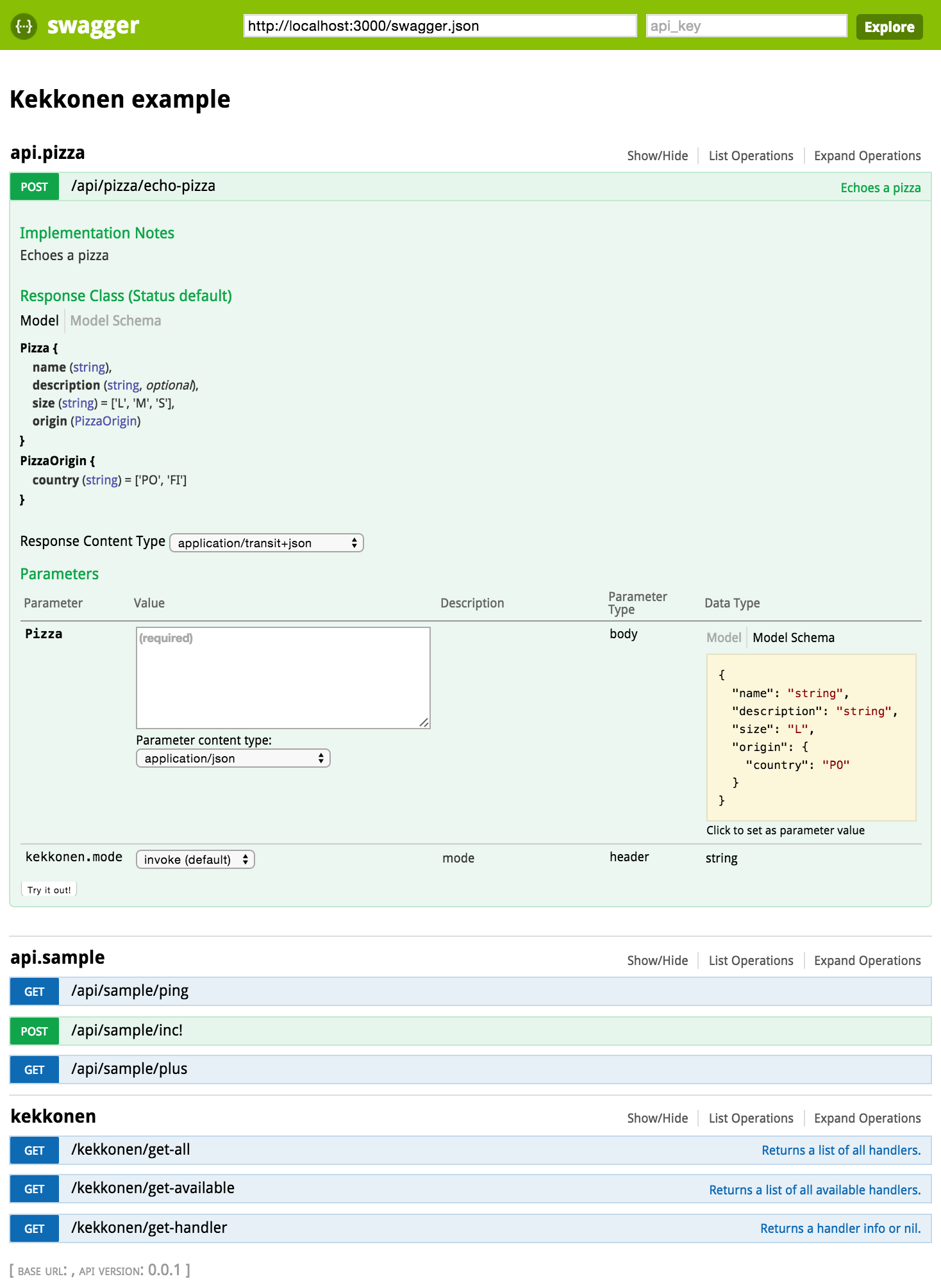A lightweight, data-driven library for creating and consuming remote service with Clojure(Script). Key features:
- not dependent on Ring/HTTP/REST, just your domain functions & data
- enables apis over HTTP, Web Sockets, Message Queues or whatever
- supports multiple api styles: Messaging, CQRS & HTTP
- Schema input & output coercion
- live & secure api-docs with Swagger
- besides invoking handlers, clients are enable to:
- securely browse the api namespaces at runtime
- check & validate single or multiple handlers without side-effects
- extract public handler meta-data for client-side reasoning
- highly extensible via options, interceptors and meta-handlers
- ships with sensible defaults
Bubblin' Under:
- all interceptors, fully async
- support for speculative transactions
- client-side bundled reads & writes
Picture of UKK © Pressfoton Etyk 1975 -team, Museovirasto
Quickstart: lein new kekkonen kakkonen
{:name ::plus
:type :handler
:interceptors []
:input {:data {:y s/Int
:x s/Int}}
:output s/Int
:handle (fn [{{:keys [x y]} :data}]
(+ x y))}{:name ::require-roles
:enter (fn [context]
(let [roles (-> context :user :roles)]
(if (seq (clojure.set/intersection roles required))
context)))}(require '[kekkonen.core :as k])
(def dispatcher
(k/dispatcher
{:handlers
{:api (k/handler {:name :hello
:handle (constantly "hello world"))}}}))
(k/invoke dispatcher :api/hello)
; => "hello world"(require '[kekkonen.cqrs :refer :all])
(require '[org.httpkit.server :as server])
(defn ^:query hello
{:input {:data {:name String}}}
[ctx]
(success (str "Hello, " (-> ctx :data :name))))
(server/run-server
(cqrs-api {:core {:handlers #'hello}}})
{:port 4000})you can invoke the hello api with http://localhost:4000/hello?name=World
(ns example.api
(:require [org.httpkit.server :as server]
[kekkonen.cqrs :refer :all]
[plumbing.core :refer [defnk]]
[schema.core :as s]))
;;
;; Schemas
;;
(s/defschema Pizza
{:name s/Str
(s/optional-key :description) s/Str
:size (s/enum :S :M :L)
:origin {:country (s/enum :FI :PO)}})
;;
;; Handlers
;;
(defnk ^:query ping []
(success {:ping "pong"}))
(defnk ^:command echo-pizza
"Echoes a pizza"
{:responses {:default {:schema Pizza}}}
[data :- Pizza]
(success data))
(defnk ^:query plus
[[:data x :- s/Int, y :- s/Int]]
(success {:result (+ x y)}))
(defnk ^:command inc! [counter]
(success {:result (swap! counter inc)}))
;;
;; Application
;;
(def app
(cqrs-api
{:swagger {:ui "/api-docs"
:spec "/swagger.json"
:data {:info {:title "Kekkonen example"}}}
:core {:handlers {:api {:pizza #'echo-pizza
:example [#'ping #'inc! #'plus]}}
:context {:counter (atom 0)}}}))
;;
;; Start it
;;
(comment
(server/run-server #'app {:port 3000}))Start the server and browse to http://localhost:3000/api-docs and you should see the following:
More examples at /examples and
info in the Wiki.
Mostly written as issues. Biggest things:
- Create namespaces with handlers from external sources (db, file, actors)
- Adapter for Websockets
- (ClojureScript) api-docs beyond Swagger
- Support for Om Next Remotes
- Clojure(Script) client & project template (re-kekkonen)
- Opinionated CQRS reference implementation, with eventing
- Graph-based dependency management
- Handler mutations & hot-swapping
- Go Async
- ClojureD 2016: http://www.slideshare.net/metosin/wieldy-remote-apis-with-kekkonen-clojured-2016
- CLojuTRE 2015: http://www.slideshare.net/metosin/clojutre2015-kekkonen-making-your-clojure-web-apis-more-awesome
Clojure multimethods introduce mutable implicit state. With multimethods, by requiring a namespace x you
could get an extra methods for a multimethod as a side-effect.
For internal functionality (like in the cljs frontends), it's totally awesome and polymorphic.
For remoting, things should be explicit and secure. With Kekkonen, handler registration is explicit and security
works like the UNIX directory structure: by not having access to namespace :api.admin, you can't have access
to any anything (sub-namespaces or handler) under that, regardless of their access policies.
Yes, it is awesome, and is used as a transport. But do you really want to handcraft you domain into POSTs, PUTs
and PATCHes do reverse-engineer back in the client? Is it easy to consume APIs that return status codes
451
or the 226?
Kekkonen tries to keep things simple. By abstracting the HTTP we can use plain clojure, websockets or queues without change in the interaction semantics.
Yes, we have reused many great ideas from fnhouse, see Special Thanks. Initial version of Kekkonen was supposed to be built on top of fnhouse but the we realized that most of the fnhouse internals would have had to be overridden due to difference in opinions.
No. But we might integrate into Pulsar.
- Schema for everything
- Plumbing for the
fnky syntax - Fnhouse for inspiration and reused ideas
- Ring-swagger for the Schema2Swagger -bindings
- Ring-middleware-format for all the data formats
- Compojure-api for some middleware goodies
Copyright © 2015-2018 Metosin Oy
Distributed under the Eclipse Public License 2.0.

